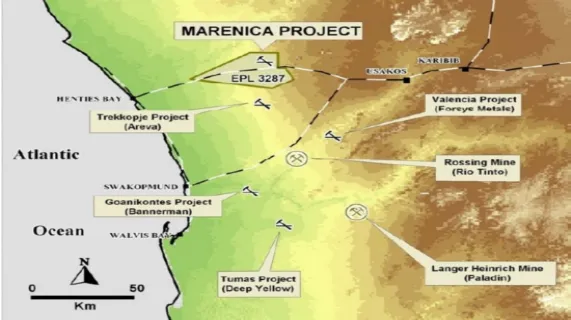
Marenica Project Central-West Namibia
Perth, Mar 5, 2008 AEST (ABN Newswire) - West Australian Metals Ltd (ASX: WME)(PNK: WAMTF) is pleased to announce initial results from an RC drill programme commenced in the December Quarter 2007 over the Marenica Uranium Project, Namibia.
The programmes' principal objective is to significantly expand the area of mineralisation outside the current resource area which contains 15 million pounds U3O8 (refer to JORC resource report to the ASX, 29 November 2007).
The drilling programme is currently focused on initially testing a 20 sq km area of a buried palaeo-drainage system immediately south and east of the resource area on a broad 600 metre by 200 metre grid pattern - the Priority Area, Figure 2. The objective is to complete this phase of drilling by the end of the March Quarter 2008 following which infill drilling will be undertaken during the June Quarter 2008 over areas identified as having resource potential. Drilling of this Priority Area is being accelerated.
Results from down hole gamma probing of the first line of 26 vertical holes totalling 1,285 metres drilled in this current programme to test the Priority Area indicates the presence of a significant envelope of uranium mineralisation (greater than 100 ppm eU3O8) extending east and southeast of the Resource Area within 40 metres of the surface.
Importantly there is an apparent thickening of mineralisation over sections of the palaeo-drainage system drilled, with five (5) holes reporting accumulated thicknesses between 10 to 15.70 metres with grades in excess of 100ppm eU3O8 - principally within the Central Channel.
This apparent thickening of mineralisation is considered significant in the context of the Company's primary goal of delineating a larger resource which could be amenable to heap leaching - such as Areva's Trekkopje Project which adjoins Marenica to the south. Significant equivalent uranium intervals from gamma probing of these initial holes include:
-----------------------------------------------Hole MAR183 3.20 metres averaging 236ppm eU3O8 (12.10-15.30 metres) and 2.50 metres averaging 298ppm eU3O8 (25.60-28.10 metres) and 7.30 metres averaging 122ppm eU3O8 (28.90-36.20 metres)Hole MAR177 1.30 metres averaging 333ppm eU3O8 (32.45-33.75 metres) and 4.70 metres averaging 121ppm eU3O8 (24.15-28.85 metres) and 2.50 metres averaging 113ppm eU3O8 (5.05-7.55 metres)Hole MAR 180 0.90 metres averaging 468ppm eU3O8 (20.39-21.29 metres)Hole MAR 170 11.30 metres averaging 126ppm eU3O8 (16.18-27.48metres)-----------------------------------------------
All mineralised intervals identified by probing have been sampled and forwarded to the laboratory for assay. Long delays are expected in receiving results due to the huge work load being carried by all laboratory facilities in South Africa and Australia.
The down hole logging, calculation of equivalent uranium grades, and compositing of mineralised intervals was conducted by geophysical consultants Terratec. All holes logged are vertically inclined, with 76 metres the deepest hole probed. The logging programme utilised a spectrometer probe to estimate uranium concentrations which were calculated and reported as equivalent (e) U or (e) U3O8 (see Note at end of this report). The estimated grades reported herein are based on calculations by Terratec using data from the uranium channel (on 10 cm interval readings) with the calculated equivalent uranium grade multiplied by a correction factor of 0.8. This correction factor has been calculated by consultants Hellman and Schofield to provide a more accurate estimate of chemical assay grade results, and was used by Hellman and Schofield in the initial resource estimation.
Results from the first phase of an infill drill programme completed in the Resource Area are still awaited. This phase consisted of 41 vertical holes (between 10-25 metres depth) drilled on a 120 metres by 120 metres grid covering an area 600 x 720 metres. This program of infill drilling has been designed to add further resources within the existing Resource Area with potential for a further 8-12 million tonnes at an average grade of 140-180ppm U3O8 (2-5 million pounds U3O8).
Further in-fill drilling in the Resource Area will be undertaken during the current quarter. Results from the on-going drilling and logging programmes will be reported when data is received and evaluated. In addition, further historic holes continue to be located both within and outside the Priority Area with probing of these holes also planned to be undertaken in the current quarter.
Notes
Down hole spectral gamma logging/probing of drill holes provides a powerful tool for uranium companies to explore for, and evaluate, uranium deposits. Such a method measures the natural gamma rays emitted from material surrounding a drill hole out to around 0.5 metre from its centre - the gamma probe is therefore capable of sampling a much larger volume than that which would normally be recovered from a core or RC hole. These measurements are used to estimate uranium concentrations with the commonly and accepted initial assumption being that the uranium is in (secular) equilibrium with its daughter products (or radio-nuclides) which are the principal gamma emitters. If uranium is not in equilibrium (viz. in disequilibrium) - as a result of the redistribution (depletion or enhancement) of uranium and/or its daughter products - then the true uranium concentration in the holes logged using the gamma probe will be higher or lower than those reported in the announcement.
Information in this report that relates to exploration results reflects information compiled by Leon Reisgys FAusIMM and Technical Director of West Australian Metals Ltd who has sufficient experience which is relevant to the style of mineralisation and type of deposit under consideration and to the activity which he is reporting on as a Competent Person as defined in the 2004 Edition of "The Australian Code for Reporting Exploration Results, Mineral Resources and Ore Reserves." Mr Reisgys consents to the inclusion in this report of the matters based on the information compiled by him, in the form and context in which it appears.
Contact
Leon Reisgys
Technical Director and Acting CEO
| ||
|


